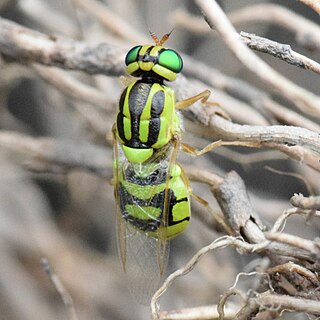
Actina chalybea is a species of 'soldier flies' belonging to the family Stratiomyidae subfamily Beridinae.

Chloromyia formosa is a species of soldier flies belonging to the family Stratiomyidae. Another name for it is Broad centurion.

Clitellaria ephippium is a species of soldier fly belonging to the family Stratiomyidae.

Pachygaster atra, the dark-winged black, is a European species of soldier fly.

Oxycera trilineata, the three-lined soldier, is a Palearctic species of soldier fly. Boldly marked in yellowish-green and black, it is found in a variety of wetlands, including pools, ditches, fens and swampy river margins. It is found in North European Russia up to Leningrad; Central Asia, Siberia. Western Europe, north up to southern Sweden.

Oxycera dives, the round-spotted major, is a European species of soldier fly.

Oxycera rara, the four-barred major, is a European species of soldier fly.

Oxycera pygmaea, the pygmy soldier, is a European species of soldier fly.

Oxycera pardalina, the hill soldier, is a European species of soldier fly.

Oxycera nigricornis, the delicate soldier, is a European species of soldier fly.

Oxycera morrisii, the white-barred soldier, is a European species of soldier fly.

Oxycera leonina, the twin-spotted major, is a European species of soldier fly.
Oxycera fallenii, the Irish major, is a Palearctic species of soldier fly. The body length is 7.0 to 9.0.mm. The abdomen has three pairs of yellow spots, in addition to a yellow base and tip. Longitudinal stripes on the mesonotum are not connected with the yellow humeral spot. The legs are entirely yellow. This species is found in South European USSR East to Siberia and Western Europe to Ireland, Central Europe, South Europe and Turkey.

Chorisops tibialis, the dull four-spined legionnaire, is a Palearctic species of soldier fly.

Beris vallata, the orange legionnaire or common orange legionnaire, is a European species of soldier fly.

Beris clavipes, the scarce orange legionnaire, is a European species of soldier fly.

Beris fuscipes, the short-horned black legionnaire, is a European species of soldier fly.

Beris geniculata, the long-horned black legionnaire, is a European species of soldier fly.

Beris is a genus of flies in the family Stratiomyidae. They are also referred to as the false soldier fly. As described by Latreille in 1802, these are small to medium sized flies with metallic colors.

Chrysops caecutiens, common name splayed deer fly, is a species of horse fly belonging to the family Tabanidae. It is also known by the colloquial name Scotch cleg.
















